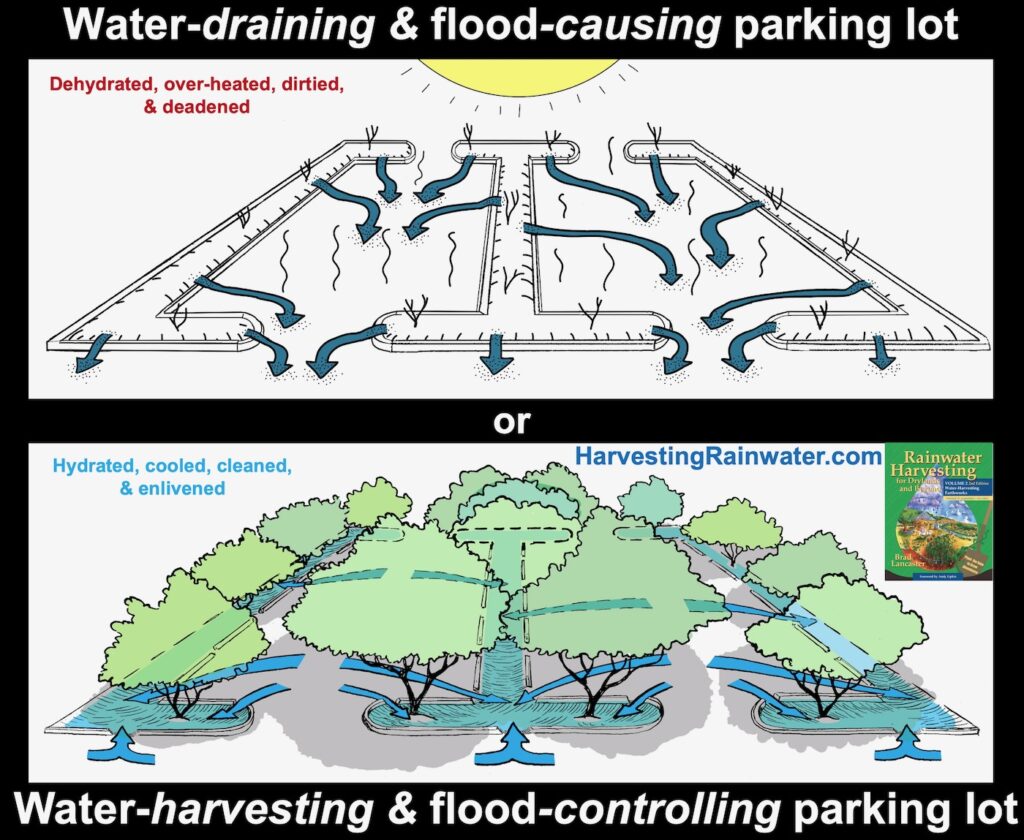Turn stormwater & snow pile runoff into runon, which is right on!
Reduce flooding and hazardous winter ice patches, while providing free irrigation to grow more cooling summer shade that also cleans our air and water.
By directing stormwater runoff (and plowed or shoveled snow) from an impervious catchment surface, such as a paved street or parking lot, to adjoining on-site rain gardens lower than the catchment surface, we can increase the amount of available rainfall, and maximize free irrigation waters to the point that no irrigation water needs to be imported. See here for a seven-year study showing many of the benefits of such water-harvesting topography.

While a water-retaining parking lot, directing its runoff water to shade trees within sunken rain gardens within the landscape strips, shades and cools our community, cleans our air and stormwater, and reduces flooding.
Reproduced with permission from “Rainwater Harvesting for Drylands and Beyond” by Brad Lancaster. Illustrations by Joe Marshall
The summer cooling effect of such water harvesting is multi-faceted. The shade trees grown with the harvested stormwater cool with their shade AND the moisture they transpire from their leaves, like a living evaporative cooler. Moisture evaporating from the soil of the rain gardens adds to this cooling effect. Thus the more water we retain in, rather than drain from, the soil of our site, the more we increase the free, passive cooling potential of the site. This is especially important as our local and global temperatures rise, and we more quickly lose more water to evaporation. Cooling slows water loss to evaporation. Fallen leaves that gather in the low spots of the rain gardens, help reduce the rate of evaporative loss of water from the soil by creating a water-absorbing, carbon-sequestering, insulation-like mulch (or soil-carbon sponge) that mitigates temperature extremes. That mulch also helps increase the rate of stormwater absorption into the soil when it rains or snows.
In wet times, the trees and understory plants within water-harvesting basins act as living pumps, pumping surplus water into the air through their transpiring leaves, while in dry times tiny beneficial bacteria and other hydroscopic microbes living in the leaves’ stomata are released into the air, and lifted by air currents high into the atmosphere to act as the ideal cloud seeds around which atmospheric water vapor condenses to form clouds and generate more rain. For more on this and other benefits of the soil-carbon sponge see here.
In winter, water-harvesting basins or rain gardens are the ideal place to deposit shoveled or plowed snow, because the water-harvesting topography will retain the snow melt, instead of draining onto the pavement where it would freeze at night and on freezing days. This way no fall-inducing ice hazards are generated on the pavement.
To get more winter sun, while also maximizing summer shade, plant winter-deciduous trees that drop their leaves in the cold months, and let the leaves accumulate as a beneficial soil-insulating, pollutant-filtering mulch within the rain gardens.
Leaves are called “leaves” because we are supposed to leave them.
To see more info, case studies, images, videos, and other resources on how to harvest street runoff & stormwater see HERE.
